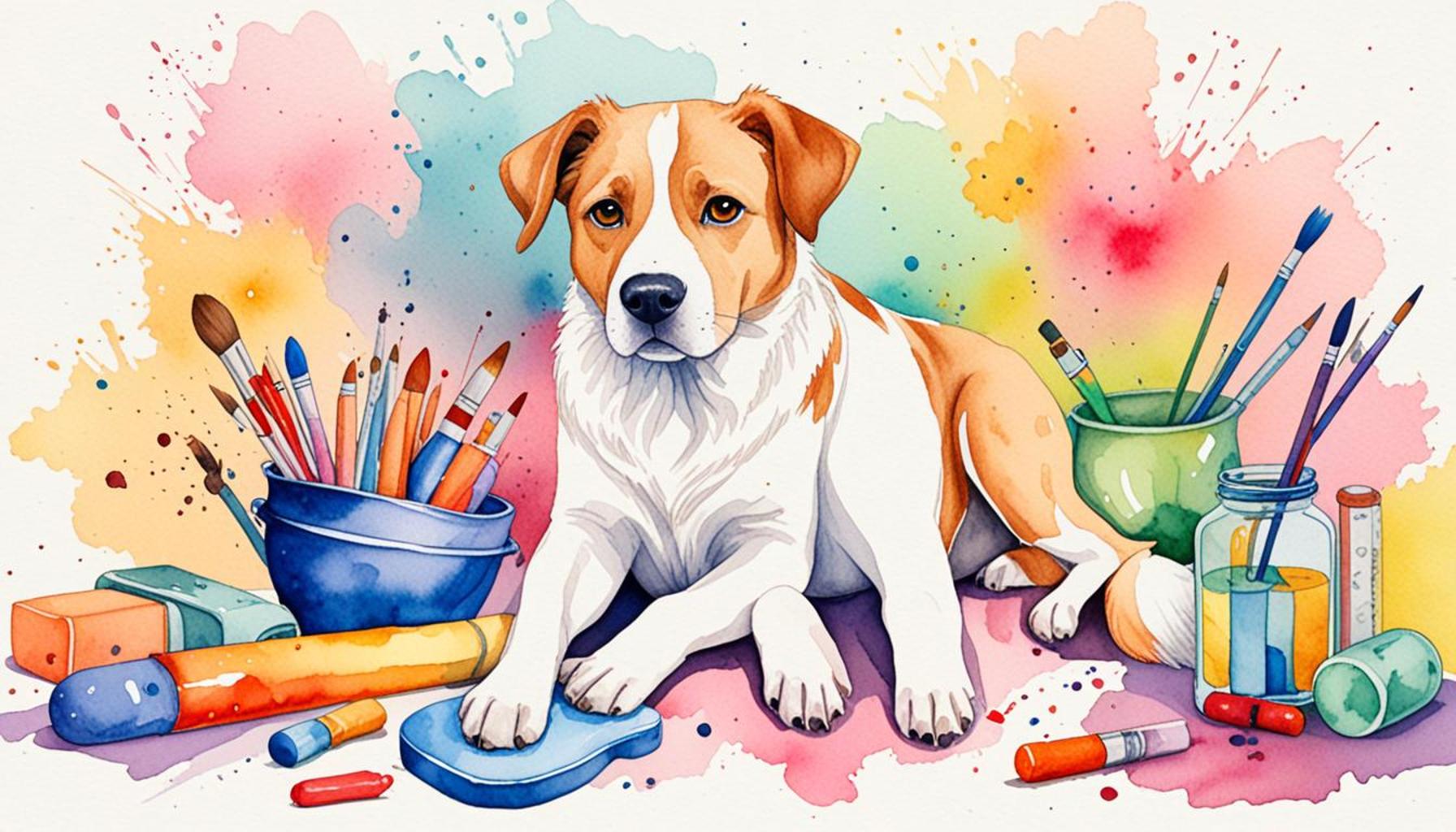Strategies for Dealing with Separation Anxiety in Dogs

Understanding Separation Anxiety in Dogs
Separation anxiety is a prevalent issue that affects many dogs across the United States. It occurs when a dog becomes extremely distressed upon being separated from their owner or guardian. Understanding this condition is crucial for pet owners who want to ensure the emotional well-being of their furry companions. Estimates suggest that around 14% of dogs in the U.S. may suffer from this condition, making awareness and intervention critical for many households.
Recognizing the signs of separation anxiety is the first step toward finding effective solutions. Common symptoms can often escalate quickly if the anxiety is severe. Some less obvious signs that owners should look for include:
- Excessive barking or howling: This vocalization often serves as a cry for help, signaling distress when you’re away.
- Destructive behavior: Chewing furniture, scratching doors, and damaging personal belongings may occur as the dog attempts to cope with their anxiety.
- Inappropriate urination or defecation: Even house-trained dogs may have accidents due to panic, which can further complicate the owner-dog relationship.
- Pacing or restlessness: A dog overly focused on their owner’s whereabouts may exhibit constant movement, trying to find a way back to you.
Being attuned to these behaviors allows dog owners to take prompt action. This emotional struggle can lead to larger issues if left unaddressed, potentially causing long-term behavioral problems or overwhelming stress for the dog. Fortunately, various strategies exist to help alleviate this anxiety:
- Gradual desensitization: Start by leaving your dog alone for short periods, gradually increasing the duration as they become more comfortable with your absence. Use this technique progressively to help them adapt.
- Positive reinforcement: Reward calm behavior with treats or praise when leaving or returning home. This creates a positive association with being alone and encourages your dog to relax.
- Creating a safe space: Designate a cozy area in your home where your dog can retreat during your absence. Filling this space with familiar toys, bedding, or even an item of your clothing can provide comfort.
By implementing these tactics, dog owners can help their pets feel more secure and relaxed during separations. Alongside these strategies, pet owners might consider consulting a veterinarian or an animal behaviorist if the anxiety appears severe. Medications and behavioral therapies are available that can assist in more complex cases.
As we delve deeper into each tactic, it becomes clear that addressing separation anxiety isn’t just about managing behaviors; it’s about building trust and promoting emotional well-being for your beloved pet. Read on to discover ways to create a more harmonious home for both you and your furry friend!
DISCOVER MORE: Click here for insights on daily routines and pet training
Effective Techniques for Addressing Separation Anxiety
When it comes to tackling separation anxiety in dogs, understanding the various strategies for dealing with this emotional challenge can make a significant difference. Addressing the issue early not only helps your dog’s mental health but also strengthens the bond between you and your furry friend. Below, we’ll delve into effective techniques designed to ease their anxiety and create a nurturing environment.
Gradual Desensitization: Building Comfort Over Time
The principle of gradual desensitization involves slowly acclimatizing your dog to being alone. Begin by leaving your dog alone for short periods, starting from just a few minutes. Over time, gradually extend this duration as they grow accustomed to your absence. This practice helps your dog learn that being alone is a normal part of life and not something to fear. For instance, if your dog remains relaxed and calm during your initial short departures, celebrate this accomplishment with a treat or affectionate praise. This process can take weeks or even months, but patience is essential in fostering a sense of security in your dog.
Positive Reinforcement: Rewarding Calmness
Using positive reinforcement is another effective strategy to combat separation anxiety. Create a routine that involves rewarding your dog for calm behavior when you leave or return home. Instead of making a grand exit or entrance that may heighten their anxiety, consider having a low-key departure and arrival routine. When your dog displays calm behavior—such as lying down or not barking—offer them a treat or verbal praise. This technique not only encourages them to remain calm in your absence but also builds a positive association with the idea of you leaving.
Creating a Safe Space: A Comfort Zone Just for Them
Another essential strategy is to create a safe space in your home where your dog can feel at ease during your absences. This area could be a specific room or a cozy corner equipped with their favorite toys, bedding, or even an item of your clothing that carries your scent. Dogs often find comfort in familiar smells, and having a designated space where they can retreat can significantly lessen their anxiety levels. Consider employing calming products such as blankets or pheromone diffusers to enhance their environment, creating an oasis of relaxation.
Implementing these methods will not only assist your dog in coping with separation anxiety, but will also foster a more peaceful atmosphere in your household. As you experiment with these techniques, always be attentive to your dog’s responses. Keep in mind that if the situation does not improve or worsens, you may want to consult a veterinarian or a professional dog trainer for specialized guidance.
With dedication and a bit of creativity, you can help your dog feel more secure and less anxious when you have to part ways. The journey toward alleviating separation anxiety can be challenging, but the rewards—an emotionally healthy pet and a happier home—are certainly worth the effort.
| Category | Details |
|---|---|
| Engagement Activities | Incorporating mental stimulation through toys or training to distract your dog. |
| Gradual Exits | Practicing short departures to build your dog’s confidence in your absence. |
| Calming Aids | Using pheromone diffusers or calming music can ease anxiety for sensitive pets. |
| Consistent Routine | Establishing a daily schedule can provide your dog with predictability and comfort during your absences. |
To effectively combat separation anxiety in dogs, leveraging strategies like engagement activities is pivotal. Keeping your pet mentally stimulated with interactive toys or positive reinforcement training can redirect their focus from anxiety-inducing thoughts. Another effective strategy involves gradual exits. By leaving your dog alone for progressively longer periods, they can learn to feel secure in your absence. Implementing calming aids, such as pheromone diffusers or soothing music, can create a serene environment that alleviates anxiety. Furthermore, establishing a consistent routine can provide a sense of stability, making it easier for your dog to adjust to your departures. Each of these strategies plays a crucial role in addressing separation anxiety and enhancing your dog’s emotional well-being.
DISCOVER MORE: Click here for insights on pet allergies
Additional Strategies to Help Alleviate Separation Anxiety
While the previously mentioned techniques are foundational in addressing separation anxiety in dogs, there are numerous additional strategies that can further support your efforts. Implementing a combination of these methods can enhance their effectiveness, making your dog feel more secure and less anxious when left alone.
Interactive Toys and Feeding Puzzles: Engaging the Mind
Another great way to combat separation anxiety is by introducing interactive toys and feeding puzzles. These products are designed to stimulate your dog mentally, keeping them occupied while you’re away. For instance, a Kong toy filled with peanut butter or a treat-dispensing puzzle can engage your dog long enough to reduce their anxiety levels significantly. This mental stimulation not only distracts them from your absence but also channels their energy in a productive manner, making the alone time feel shorter.
Regular Exercise: The Importance of Physical Activity
Ensuring your dog receives adequate physical activity is crucial in managing separation anxiety. Regular exercise can help reduce general anxiety levels; this could include long walks, trips to the dog park, or engaging in playful activities at home. A dog that is physically tired is less likely to exhibit signs of anxiety. Aim for at least 30 minutes to an hour of exercise each day, depending on your dog’s breed, age, and overall health. This practice will not only alleviate anxiety but significantly improve your dog’s overall well-being.
Establishing a Consistent Routine: Predictability as Comfort
Dogs thrive on routine. Establishing a consistent schedule for feeding, walks, and playtime can provide your dog with a sense of predictability that eases their anxiety about your departures. For example, if your dog knows that you typically leave for work shortly after breakfast, they can settle into the routine rather than worrying about when you might leave. This predictability makes your absence less distressing and helps them develop coping strategies when you do leave.
Consider Professional Help: When to Seek Assistance
In some cases, despite attempting various strategies, your dog may continue to struggle with severe separation anxiety. In such instances, seeking professional assistance can be beneficial. Collaborating with a veterinarian or a certified dog trainer specializing in behavior can provide you with tailored approaches that address your dog’s specific needs. They might recommend therapies such as behavior modification or, in some cases, medication to help reduce anxiety levels and allow for more effective training.
Utilizing Calming Products: Aiding Relaxation
Industries have developed various calming products aimed explicitly at helping anxious dogs. These items include calming collars infused with pheromones, anxiety wraps that apply gentle pressure to your dog’s body, or calming music specifically designed for dogs. Experimenting with these products may offer additional layers of comfort and relaxation during the times you are away, especially for dogs who have proven more sensitive to stressors.
As you explore these diverse strategies for dealing with separation anxiety in dogs, keep in mind that each dog is unique. Their responses to different approaches can vary, and tailoring these methods to fit your dog’s needs will yield the best results. By employing a multifaceted approach that considers physical, emotional, and environmental elements, you are on your way to helping your beloved companion overcome their fears and anxieties.
LEARN MORE: Click here to discover how positive training can enhance your pet’s behavior
Conclusion: A Holistic Approach to Managing Separation Anxiety in Dogs
In conclusion, addressing separation anxiety in dogs requires a comprehensive and compassionate approach tailored to your pet’s unique needs. By implementing a combination of strategies including interactive toys, regular exercise, and establishing a consistent routine, dog owners can effectively mitigate the symptoms of anxiety. Each of these elements contributes not only to your dog’s mental and physical health but also fosters a sense of security and comfort in their environment.
Moreover, it’s essential to recognize the value of professional intervention when necessary. Sometimes a behavioral expert can provide insights and techniques that have not been considered, making substantial differences in your dog’s ability to cope with separation. In addition, experimenting with calming products can further aid in reducing distress, providing an additional layer of reassurance that may ease your dog’s anxiety.
Through patience, understanding, and consistent effort, you can help your dog navigate their feelings of unease when faced with separation. The goal is not solely to alleviate anxiety but to foster a stronger bond and enhance overall well-being. As you implement these strategies, you may uncover new layers of your dog’s personality and improve your shared experiences together. Thus, turning a challenging situation into a journey of understanding and companionship.


